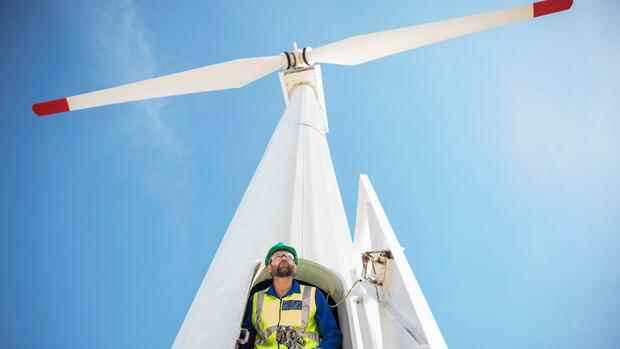The wind companies are having a hard time with the high prices.
(Photo: imago images/Westend61)
Dusseldorf In September, just 87 bidders with their wind farms for 772 megawatts applied for the subsidies for the expansion of onshore wind power. That’s not even 60 percent of the available amount, as the Federal Network Agency announced on Wednesday. Prices vary between 5.7 and 5.8 cents per kilowatt hour.
“The signing of the tender again exacerbates the problem of the sluggish expansion of the urgently needed wind turbines,” warned Kerstin Andreae, chairwoman of the Federal Association of Energy and Water Industries (BDEW). The main reason for the low interest is “significant” cost increases for wind turbines due to higher raw material and financing costs.
However, the expansion of wind power in Germany has been paralyzed for years. For three years, no more than 500 wind turbines have been installed per year. In order to achieve the new climate target – an 80 percent share of renewable electricity by 2030 – 1500 to 2000 systems would have to be built annually.
The reasons for the sluggish expansion are manifold. Insufficient available space, strict distance rules, lengthy approval procedures and more and more lawsuits against the meter-high turbines have been hampering the wind market in Germany for a long time. Although the numbers are better than three years ago, they are stagnating at a low level.
Top jobs of the day
Find the best jobs now and
be notified by email.
Three times a year, in February, May and September, the federal government distributes the funds for 1329 megawatts of wind energy each time via auctions. Everyone can apply with their planned projects and a certain price. The lowest bids get the contract and a guaranteed payment for the green electricity.
Listen to the podcast here: The problem with wind power
The tender round in May was also clearly undersigned, i.e. below what is actually possible. In view of the disastrous results, BDEW boss Andreae called for the legislature to “at least temporarily adjust the maximum bid values in the Renewable Energy Sources Act (EEG)”.
According to the EEG, it must not be more expensive than 5.88 cents per kilowatt hour. This is how the legally prescribed price reduction provides: The upper limit was lowered from 6.00 cents to 5.88 cents per kilowatt hour this year.
>> Read here: wind company Siemens Gamesa cuts 2900 jobs
Economics Minister Robert Habeck (Greens) had introduced several legislative packages to improve the framework conditions, especially for the expansion of onshore wind power. For example, two percent of the land area in each federal state is to be reserved for wind energy over the coming years. However, the first interim target at the end of 2027 is much too late, criticizes the wind industry.
All experts agree that the expansion of wind power in Germany must be much faster. Last year, wind power accounted for around 24 percent of total electricity consumption in Germany. It has been the most important energy source in power generation since 2020. If the targeted phase-out of coal by 2030 or 2035 remains, this share still has to increase significantly.
More: 235 wind turbines newly set up in Germany – it should be more than three times as many

